A Changing World
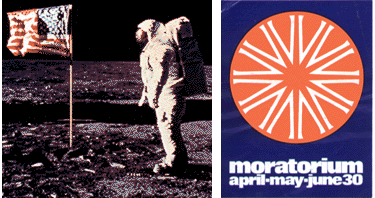 Images of 1969: a human on the Moon (Apollo 11), and a poster for the Anti-Vietnam War Moratorium
Images of 1969: a human on the Moon (Apollo 11), and a poster for the Anti-Vietnam War Moratorium
The period of the Vietnam War through to the Bicentenary of European settlement in 1988 was a time of fundamental social and economic, scientific and technological change in New South Wales and throughout the world. A form of social revolution was transforming the political and social landscape in Western countries. Many of the old certainties and accepted values came under question, particularly from youth including students at the now rapidly expanding universities. In Australia, the Vietnam War and conscription generated a protest movement which attained a significant scale and was also part of wider world peace and anti-nuclear movements. The dimension of social change also encompassed the women’s movement, anti-racism and anti-apartheid activism, environmental activism, sexual liberation, disability awareness, anti-discrimination, a youth drug culture, heritage and conservation awareness, a broad rejection of society by some, upheaval in religious bodies, deepening political cynicism, and much more. New South Wales, and Sydney in particular, became a distinctly multicultural society as the long maintained White Australia Policy was abandoned at last and large numbers of non-European migrants began to make their home in Australia, some of whom were overseas students and other refugees following the end of the Vietnam war.
Television, satellites, improved telecommunications, new personal computer technology, jet aircraft and cheaper fares transmitted people, ideas and movements faster than ever within and beyond Australia as well as exposing people more to the realities of war, terrorism, environmental problems and international crises. The world was changing rapidly and, just as rapidly, so was our awareness of it.
The Political Balance
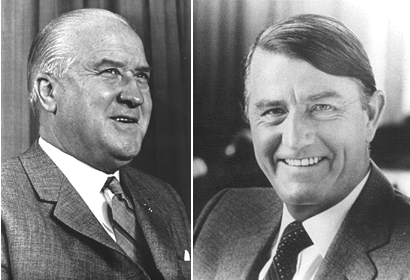 The dominant Premiers of the period: Robin (Later Sir Robert) Askin (left); and Neville Wran
The dominant Premiers of the period: Robin (Later Sir Robert) Askin (left); and Neville Wran
The unbroken quarter century of Labor governments came to an end in 1965 and the period that followed up until 1988 almost equally divided between the Liberal/National Party and Labor, and dominated by two men, Askin and Wran, who both served record terms as Premiers.
In May 1965, a Liberal-Country Party coalition led by Robin (later Sir Robert) Askin was elected to office. Askin dominated politics until his retirement in 1975. He was followed by Tom Lewis for less than 12 months and then Sir Eric Willis until the election four months in May 1976. The L-CP government was defeated and the new Labor government was led by Neville Wran who managed a succession of major electoral successes (popularly called “Wranslides”) to serve the longest unbroken term as Premier in New South Wales’ history. Wran retired in July, 1986 and his successor, Barry Unsworth, led the Labor Government until its defeat in March, 1988.
For the most part it was a period of considerable growth, prosperity (and steady inflation). Government policies were slow to reflect some of the social transformation underway but eventually significant new directions in environmental and conservation protection and anti-discrimination emerged. Politically, around election time this was an era of “big promises”, and expenditures increased considerably as a result. Public transport and education outlays increased. State Aid to church schools was a major and controversial issue at the beginning of this period, but gradually the major parties committed themselves to significant government funding to non-government schools. The political parties themselves, though still male and Anglo-Celtic dominated, began to reflect some these changes and new concerns in their polices. It was clear, too, that the old connections between social class or occupation, and voting patterns, was also breaking down to some extent. Both major political parties began to shift their attention towards the political “middle ground”.
The Wran years saw some significant constitutional and electoral change. The Legislative Council was reformed in 1978 to reduce it to 45 Members elected on a state-wide basis by popular vote; the voting age was reduced to 18 in 1973; the term of the NSW Parliament was extended to 4 years in 1981; equal value votes were enshrined by removing the bias favouring non-metropolitan electorates; and National and State Parliaments passed the Australia Acts which cut the last legislative links with Britain in 1986.
Federally, the retirement of Liberal Party Prime Minister Robert Menzies in 1966 changed the political scene. His successors, Harold Holt (whose sudden death by drowning shocked the nation in 1967), John Gorton and William McMahon, faced increasing discontent and a reviving Labor Party under the leadership of Gough Whitlam. Whitlam won the 1972 election, instituting a program of reform which produced both radical change and reaction. The process of centralisation and relegation of State powers to Federal control also accelerated. After Whitlam’s controversial dismissal in 1975 the new Federal Liberal-National Party government led by Malcolm Fraser only marginally reversed this trend. In 1983. Bob Hawke’s Labor Government won power and despite policies"consensus" and "new Federalism" and economic deregulation, tensions and funding concerns between state and Commonwealth government continued.
This period also saw and increased public cynicism about politics and government, partly driven by the mass media and mainly sourced beyond state politics. President Nixon’s resignation, Vietnam and the American alliance, Prime Minister Holt’s death, the Whitlam controversies and dismissal, reaction to Bjelke-Petersen’s premiership in Queensland, and general social disillusionment with social and environmental problems all contributed to the attitudinal change. In addition, in New South Wales, media and rumour mills were increasingly focussed on stories of organised crime and police and political corruption, and problems with criminal justice and prisons.
Rebuilding Parliament House
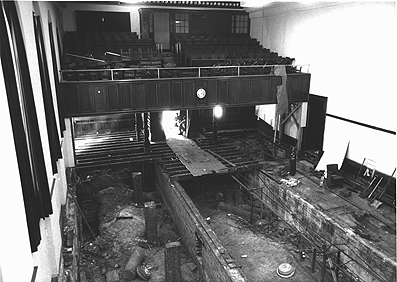 A thorough restoration job: the Legislative Council Chamber in 1978 as the heritage sections of the Parliament were being brought back to their turn-of-the-nineteenth century splendour
A thorough restoration job: the Legislative Council Chamber in 1978 as the heritage sections of the Parliament were being brought back to their turn-of-the-nineteenth century splendour
The problem of the inadequate Parliament buildings was apparent from the 1850s. At various times grand plans were drawn up – a foundation stone for the new building was even laid in 1888 (to be quietly removed some years later) – but no government was prepared to face the cost of the proposals. Instead the make-shift process of adaptation continued with a largely sub-standard collection of minor buildings tacked on to the back of the old rum hospital and the chambers.
Finally in the 1960s serious attention was focussed n the problems of Parliament’s accommodation. Changing social attitudes in the decade which followed led instead to a plan which would preserve the historic fabric of the building, especially on the Macquarie Street frontage, but provide contemporary accommodation and services at the rear.
Remarkably, this time the project was adopted and work commenced in 1974. Over the next ten years, the rambling structures at the rear of the building were demolished, a 12-storey block and the interlinking “fountain court” area were constructed, and the historic Rum Hospital building, the legislative chambers, the library reading room and the legislative foyers were restored.
Democratising the Legislative Council
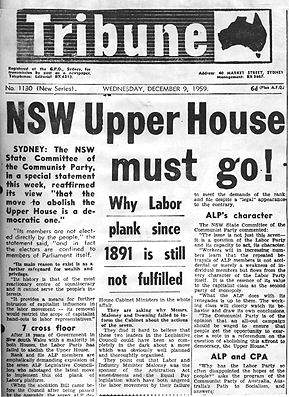 The Communist paper Tribune makes its view clear on the future of the Legislative Council in 1959
The Communist paper Tribune makes its view clear on the future of the Legislative Council in 1959
After the reforms of 1934, the replacement of only a quarter of the membership of the Council every three years meant the House was rarely reflecting the political preferences of the majority of the electorate at any particular time. The Labor Party, which held government in the Legislative Assembly from 1941 to 1965, remained committed to the abolition of the Council. Attempts to reform or abolish the Council in 1943 and 1946 failed, as did a private member's bill in 1952. In 1959, Labor Premier Heffron introduced another Bill for the Council's abolition which, after extended debate, was soundly defeated at a referendum in 1961.
In 1977, the Wran Labor Government introduced a Bill to reform the Upper House but it was not passed by the Legislative Council. After two months, the Bill was re-introduced and after extensive negotiations between the two Houses an agreement was reached. The amended Bill was presented to the people and approved at a referendum in June, 1978. As a result the Legislative Council became a House of 45 members directly elected by the people by a system of proportional representation to represent the whole state. One third (15) of the Members retired at each General Election for the Legislative Assembly. The maximum three year term of the Legislative Assembly was three years so that Legislative Councillors had a term of up to 9 years. In 1981 the maximum term of Parliament was increased to 4 years, increasing the maximum term for Legislative Councillors to 12 years.
In 1991, as the result of a Greiner Government referendum, the number of Members in both Houses were reduced, the Legislative Council to 42 Members, half of whom (21) were to retire or stand for re-election at each General Election (i.e. a maximum of 4 years).
The Constitution (Fixed Term Parliaments) Amendment Bill was agreed to at a referendum on 25 March 1995. This Bill provides that elections for the Legislative Council and Legislative Assembly are held every 4 years, which means that Members of the Legislative Council are now elected for a fixed term of 8 years (two terms of the Legislative Assembly).
The proportional system of voting used for the Council results in a very representative spread of seats where minor parties have a good chance of gaining representation in proportion to their level of support. As a result no single party gained a majority in the Council from 1988 onwards.
Bicentenary of a Nation
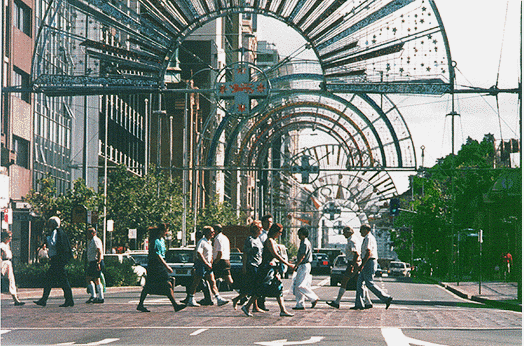 Macquarie Street renovated as well as decorated again, this time for the Bicentenary of European settlement in Australia in 1988
Macquarie Street renovated as well as decorated again, this time for the Bicentenary of European settlement in Australia in 1988
In 1988, Australia celebrated the bicentenary of European settlement. As the first settlement had been at Sydney Cove, it was inevitable that New South Wales and Sydney were at the centre of events, particularly on Australia Day, 26 January. Much centred on Sydney Harbour with sail pasts and fly pasts, a first fleet re-enactment, fireworks and concerts for the millions lining the Harbour shores. The Parliament of New South Wales played a major part in those celebrations, although the state election due in March was also occupying the attention of many Members.
As well as celebrating many significant achievements, including the development and maintenance of one of the world’s oldest and most stable democratic systems, it was also a time to reflect on the state of play in the nation.
Much had been done to develop the physical assets of central Sydney in a pre-1988 building boom, some of it controversial, but Sydney had certainly become a major world tourist destination. The problem of reconciliation with indigenous Australians was highlighted by the celebrations and there was concern that the much-vaunted egalitarianism and community values of Australian way of life were changing. Sydney had become highly multicultural in its nature although as yet citizens from non-English speaking backgrounds were rarely playing major parts in political affairs. The status and role of women had altered significantly over a decade or more but the number of women in politics and senior management was only now beginning to change. Social problems with drugs, youth unemployment, poverty and crimes of violence seemed on the increase. Law and order had become a popular plank at election time. Economically, Australia, always highly dependent on international trade, was clearly becoming part of an increasingly global economy and society where state and even national governments had less control over events. 1988 was an important moment in the nation and the state but it also highlighted the fact that the time ahead would have many challenges as well.
